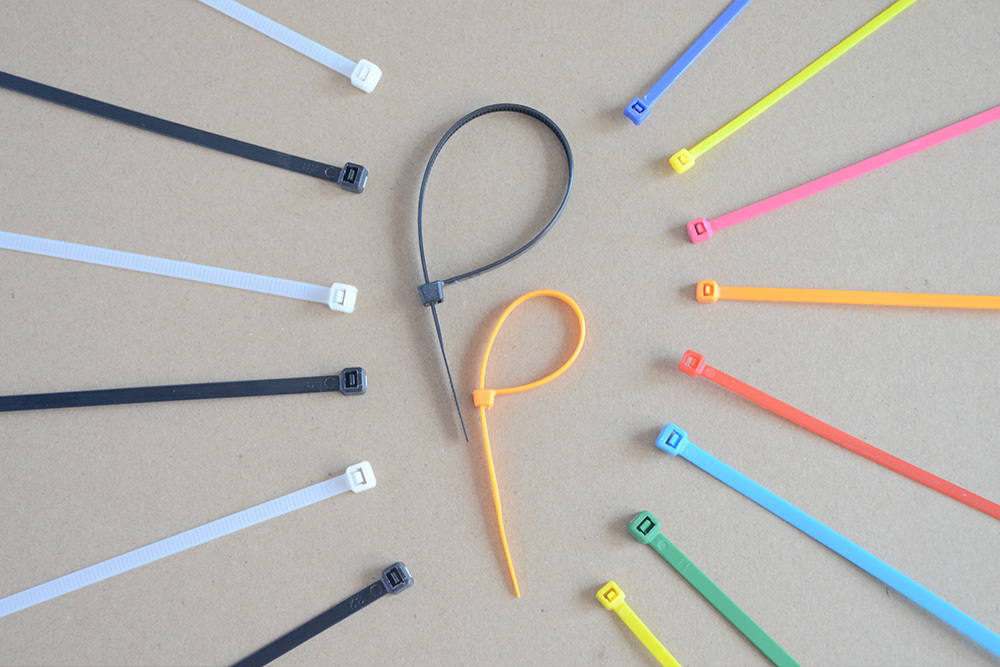09
2025
-
10
Insect-proof plastic cable ties
Author:
Material Advantages of Insect-Resistant Plastic Cable Ties for Industrial and Outdoor Applications
Plastic cable ties, essential for organizing cables and securing equipment, face unique challenges in environments prone to insect activity. Standard ties may degrade when exposed to bites, secretions, or nesting behaviors of pests, leading to premature failure. Insect-resistant plastic cable ties address these issues through specialized material formulations, offering enhanced durability and reliability. Below, we explore the key material properties that make these ties suitable for pest-prone settings.
High-Density Polyethylene (HDPE) and Its Resistance to Insect Damage
High-density polyethylene (HDPE) is a thermoplastic polymer widely used in insect-resistant cable ties due to its chemical inertness and physical robustness. Unlike softer plastics, HDPE’s dense molecular structure resists penetration by insect mandibles, making it difficult for pests to chew through. This property is particularly valuable in agricultural settings, where cable ties secure irrigation systems or fencing exposed to rodents, ants, or beetles.
HDPE’s resistance extends beyond mechanical damage. Insects often secrete acidic or enzymatic substances to break down materials for nesting. HDPE’s non-reactive surface minimizes chemical degradation, ensuring ties remain intact even after prolonged exposure. For example, in grain storage facilities, HDPE-based ties secure wiring without succumbing to the corrosive effects of insect excretions, reducing maintenance costs and safety risks.
Applications in Agriculture and Food Processing
In agriculture, HDPE cable ties secure greenhouse structures, vineyard trellises, and livestock fencing. Their resistance to insect bites prevents animals from escaping due to damaged ties. Similarly, in food processing plants, where hygiene is critical, HDPE ties resist contamination from pests and withstand cleaning chemicals, maintaining compliance with safety standards.
Polyamide 66 (PA66) and Its Dual Resistance to Insects and Environmental Factors
Polyamide 66 (PA66), a nylon variant, combines insect resistance with superior mechanical performance. Its high tensile strength and thermal stability make it ideal for outdoor and industrial applications where ties endure both pest activity and temperature fluctuations. PA66’s smooth surface reduces friction, minimizing the likelihood of insects clinging to or nesting on ties—a common issue with rougher plastics.
Insects like termites and carpenter ants are drawn to cellulose-based materials but avoid synthetic polymers like PA66. This natural aversion enhances the material’s effectiveness in forested or rural areas, where pest populations are high. For instance, in telecommunications infrastructure, PA66 ties secure cables in utility poles without attracting wood-boring insects, ensuring long-term reliability.
Performance in Harsh Climates
PA66’s resistance to UV radiation and moisture complements its insect-repellent properties. In tropical regions, where humidity accelerates insect activity, PA66 ties maintain structural integrity without weakening. Similarly, in cold climates, the material’s low-temperature flexibility prevents brittleness, a common issue with inferior plastics when exposed to freezing conditions.
Polypropylene (PP) and Its Cost-Effective Insect-Resistant Solutions
Polypropylene (PP) offers a budget-friendly alternative for insect-resistant cable ties, suitable for light-duty applications. While not as robust as HDPE or PA66, PP’s chemical stability and moderate strength make it viable in controlled environments like warehouses or indoor facilities. Its resistance to insect bites stems from its semi-crystalline structure, which resists cracking under stress.
PP’s affordability enables widespread adoption in projects requiring large quantities of ties, such as event setups or temporary installations. For example, in outdoor festivals, PP ties secure lighting and sound equipment without attracting pests, ensuring quick assembly and disassembly.
Environmental Sustainability
PP’s recyclability adds an eco-friendly dimension to insect-resistant ties. Manufacturers increasingly use recycled PP to reduce waste, appealing to industries prioritizing sustainability. In urban green spaces, recycled PP ties secure plant supports while deterring insects, balancing functionality with environmental responsibility.
Material Selection Considerations for Pest-Prone Environments
Choosing the right material for insect-resistant cable ties depends on application-specific demands. HDPE excels in high-pest-density areas requiring longevity, while PA66 suits extreme climates with dual environmental and insect challenges. PP offers a cost-effective solution for short-term or indoor projects.
Industry-Specific Use Cases
- Construction: HDPE ties secure scaffolding in areas with high rodent populations.
- Renewable Energy: PA66 ties organize solar panel cables in desert regions prone to ant infestations.
- Retail: PP ties bundle merchandise displays in warehouses with occasional pest issues.
By aligning material properties with environmental risks, professionals can optimize cable tie performance, reduce replacement frequency, and enhance operational efficiency in pest-prone settings.
plastic cable ties
Hot News
2025-10-09
Insect-proof plastic cable ties
Plastic cable ties, essential for organizing cables and securing equipment, face unique challenges in environments prone to insect activity. Standard ties may degrade when exposed to bites, secretions, or nesting behaviors of pests, leading to premature failure. Insect-resistant plastic cable ties address these issues through specialized material formulations, offering enhanced durability and reliability. Below, we explore the key material properties that make these ties suitable for pest-prone settings.
2025-10-09
Advantages of dust-proof plastic cable ties
Plastic cable ties, commonly known as zip ties, are indispensable tools across industries due to their versatility and cost-effectiveness. When designed with dust-resistant properties, these ties gain additional benefits that enhance their performance in environments prone to particulate contamination.
2025-10-08
Application scenarios of waterproof plastic cable ties
Waterproof plastic zip ties, engineered with materials like UV-stabilized nylon or polypropylene, are designed to resist moisture, chemicals, and environmental degradation. Their durability and adaptability make them indispensable across industries and daily life. Below are key applications where these ties excel.
2025-10-08
Surface treatment of anti-slip plastic cable ties
Plastic zip ties are essential for securing items, but their smooth surfaces can sometimes lead to slippage, especially under tension or in wet conditions. This compromises both functionality and safety, particularly in applications like construction, automotive repairs, or outdoor installations. By applying specialized surface treatments, manufacturers can significantly improve the grip and durability of zip ties, ensuring they stay firmly in place even in challenging environments.

